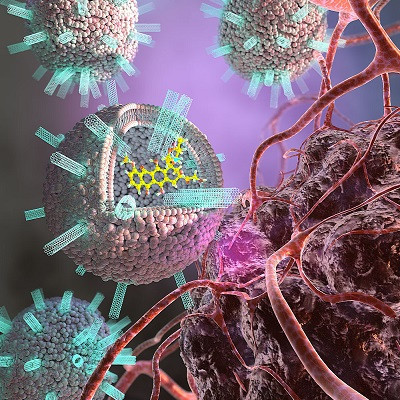
2022-02-01
Visited : 2475
Liposomes studded with carbon nanotubes and carrying a chemotherapy drug dock to the surface of a cancer cell. This causes the liposome to fuse to the cancer cell and deliver the drug, killing the cell.
Fundamental science often finds applications beyond its original focus. Previously, scientists found applications for small diameter carbon nanotube porins in energy technology. Nanotube porins are tubes with walls just molecules thick that act as pores through the walls of a thin membrane of liposomes, a type of tiny synthetic particle. Scientists have now assembled these nanotubes in a new way to deliver a cancer drug. The key is that the nanotubes pull the liposomes and the cancer cells together, allowing the membranes of the liposome and cancer to mix. This fusion process allows the drug to freely pass from the liposome to the cell. This results in very effective delivery of the anticancer drug doxorubicin, killing up to 90 percent of diseased cells.
This new pathway to deliver a drug directly into a cell interior addresses a long-standing challenge for medicine. It provides a new platform for understanding how to precisely deliver a wide range of drugs to individual cells. This understanding will potentially enhance the arsenal of innovative drug carriers for treatment of difficult to cure diseases. Another potential application includes more efficient methods for administering vaccines.
Carbon nanotube pores that create and maintain water “wires” could allow for rapid transport of protons in next-generation, artificial, proton-conducting membranes. These membranes could lead to applications such as more efficient fuel cells for powering cars and homes. Scientists have now used reconfigured versions of these same carbon nanotubes to directly introduce the anticancer drug doxorubicin from spherical sacs of phospholipid molecules (liposomes) through the cell plasma membrane into its interior. Chemotherapy is an effective treatment for many cancer patients but delivering these drugs into unhealthy cells is still quite difficult. Doctors have used liposomes to deliver therapeutic drugs to diseased cells for some time. However, this process usually follows an inefficient delivery pathway, and the drugs are often destroyed before they get to the cells. This pathway is bypassed when small diameter, carbon nanotube porins are incorporated into liposomes full of the anticancer drug. These porins allow fusion of liposome and cell membranes, permitting direct delivery of the drug. Computational simulations revealed that tiny dimers of carbon nanotubes embedded in the exterior of the liposome membrane first tether the liposome and cell membranes together very closely. Mixing of the membranes induced by such proximity causes the cells and liposomes to blend. This leads to direct delivery of the drug, killing most of the cancer cells.
Read the original article on Department of Energy (DOE).